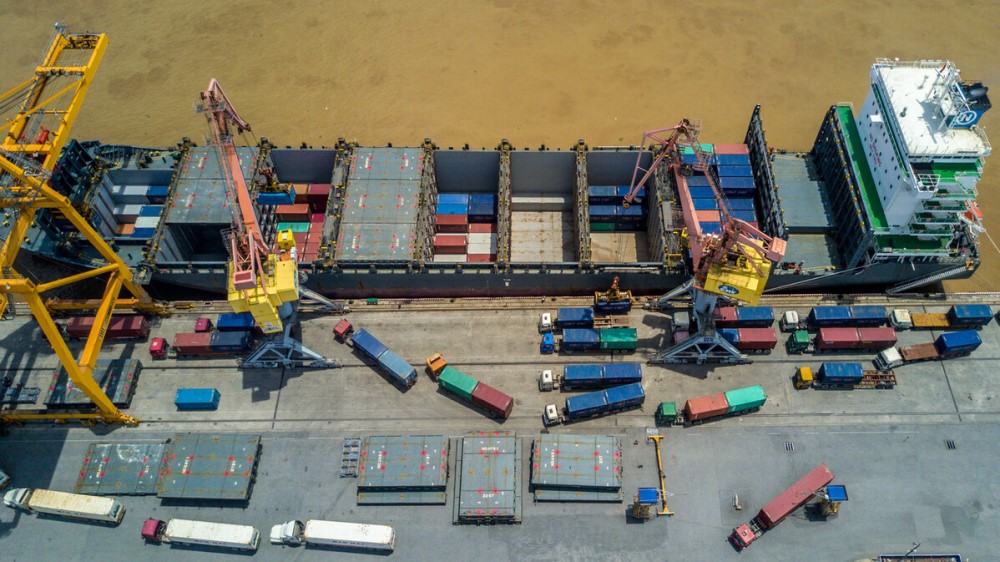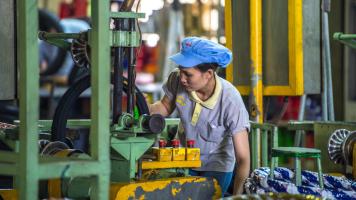
The criteria for the transportation and storage sector were aligned where appropriate with relevant sectoral guidelines and regulations, such as the International Maritime Organisation (IMO) 2023 GHG Emissions strategy. Photo credit: ADB.
Southeast Asia advanced efforts to guide capital and funding toward sustainable activities in carbon-intensive sectors.
Southeast Asia advanced efforts to guide capital and funding toward sustainable activities across the region by defining green projects in the transportation and storage and construction and real estate sectors.
The ASEAN Taxonomy Board (ATB) released last month Version 3 of the ASEAN Taxonomy for Sustainable Finance. It includes technical screening criteria for assessing such activities as transport infrastructure for land, water, and air transport; urban and freight transport; construction and renovation of buildings; demolition and site preparation; and acquisition and ownership of buildings.
Still dominated by fossil-fuel vehicles, the transport sector is one of the largest sources of both urban and regional air pollution, contributing about a quarter of energy-related greenhouse gas emissions in the world.
Energy demand and emissions from the building and construction sector represent over a fifth of global emissions. The built environment (e.g., houses, schools, workplaces, commercial buildings) uses energy to heat, cool, and power itself and generates carbon emissions throughout its lifespan—from construction to operation to demolition and disposal of building materials.
“The release of Version 3 marks a significant step forward in our collective efforts to accelerate sustainable development and responsible investment practices in the ASEAN region. The issuance of the TSC [technical screening criteria] for Transportation & Storage and Construction & Real Estate underscores our unwavering commitment to fostering sustainability. We look forward to engaging with stakeholders to ensure the rigor and practicality of the Taxonomy,” said Brunei Darussalam Central Bank Deputy Managing Director Noorrafidah Sulaiman, who currently chairs ATB.
A common guide to an inclusive and just transition
The ASEAN Taxonomy is an initiative of the ASEAN Capital Markets Forum (ACMF), the ASEAN Insurance Regulators Meeting (AIRM), the ASEAN Senior Level Committee on Financial Integration (SLC), and the ASEAN Working Committee on Capital Market Development (WC-CMD). It is designed to be an inclusive and science-based classification system to support the 10 ASEAN member states’ shift to low-carbon and sustainable development. It has four environmental objectives: climate mitigation, climate adaptation, protection of healthy ecosystems and biodiversity, and resource resilience and the transition to a circular economy. An activity must show that it contributes to at least one of these objectives to be classified under the taxonomy.
ASEAN introduced Version 1 of the taxonomy in November 2021 in time for the COP21 climate talks in Glasgow. Version 2 was released in March 2023 and took effect in February this year after incorporating feedback from consultations with stakeholders. It provided the technical screening criteria for the Electricity, Gas, Steam and Air Conditioning Supply (Energy) sector and included guidance on coal phaseout, which was a global first for a regional taxonomy.
Versions 2 and 3 build on the multi-tiered framework outlined in Version 1. It is multi-tiered to facilitate the transition of ASEAN member states, which have varying levels of economic, finance sector, and infrastructure development. This allows for different starting points in the transition journey for a diverse range of potential users—governments, companies, investors, etc. The ASEAN Taxonomy uses two assessment approaches: the Foundation Framework—a principles-based assessment using qualitative, sector-agnostic screening criteria, and the Plus Standard Framework, which provides sector-specific technical screening criteria.
Version 2 provides the complete Foundation Framework with detailed methodologies for assessing economic activities and provides guide questions, decision trees, and use cases. The framework was developed as a “starter” assessment method.
Energy, transportation and storage, and construction and real estate are three of six focus sectors under the Plus Standard Framework, which is a more advanced form of assessment. The others are agriculture, forestry and fishing; manufacturing; and water supply, sewerage and waste management. The target is to develop the technical screening criteria in phases and finalize them by 2025.
A science-based tool
The taxonomy classifies activities as either green, amber (transitional), or red (not aligned). Under the Plus Standard Framework, the green tiers are benchmarked to the 1.5°C Paris Agreement target and refer to widely used international taxonomies, such as the European Union Taxonomy, while the amber tiers promote inclusivity by serving as stepping stones toward moving up to green tiers.
The green tiers for the transportation and storage and construction and real estate sectors have been aligned where appropriate with relevant sectoral guidelines and regulations, such as the International Maritime Organisation (IMO) 2023 GHG Emissions strategy and international green building certifications (e.g., LEED, BREEAM). This ensures credibility, interoperability, and inclusiveness while reducing regulatory fragmentation.
Activities classified as red include new roads, road bridges, road upgrades, parking facilities, fossil fuel filling stations, and oil tankers or other ships solely transporting coal or oil.
National taxonomies
In her foreword, Sulaiman said “efforts to grow the sustainable finance ecosystem have accelerated commendably” after the ASEAN Taxonomy was introduced. She noted that Indonesia, the Philippines, and Singapore released their taxonomies last year, with key aspects aligned to the ASEAN Taxonomy. She remarked that this reinforces “the ASEAN Taxonomy’s role as the common language for sustainable finance in the region and the importance of an inclusive, overarching guide for the region.”
Version 3 also includes refinements to the taxonomy’s Annexes to provide more clarity to the user. The changes include the following:
- Annex 2: Additional clarification and worked examples for the Life Cycle Assessment (LCA) checklist;
- Annex 3: Additional clarification and worked examples for the Climate Risk and Vulnerability Assessment (CRVA) checklist;
- Annex 5: Updated national social regulations for Indonesia, Malaysia, and the Philippines; and
- Annex 6: Updated national environmental regulations for Indonesia and Malaysia.

